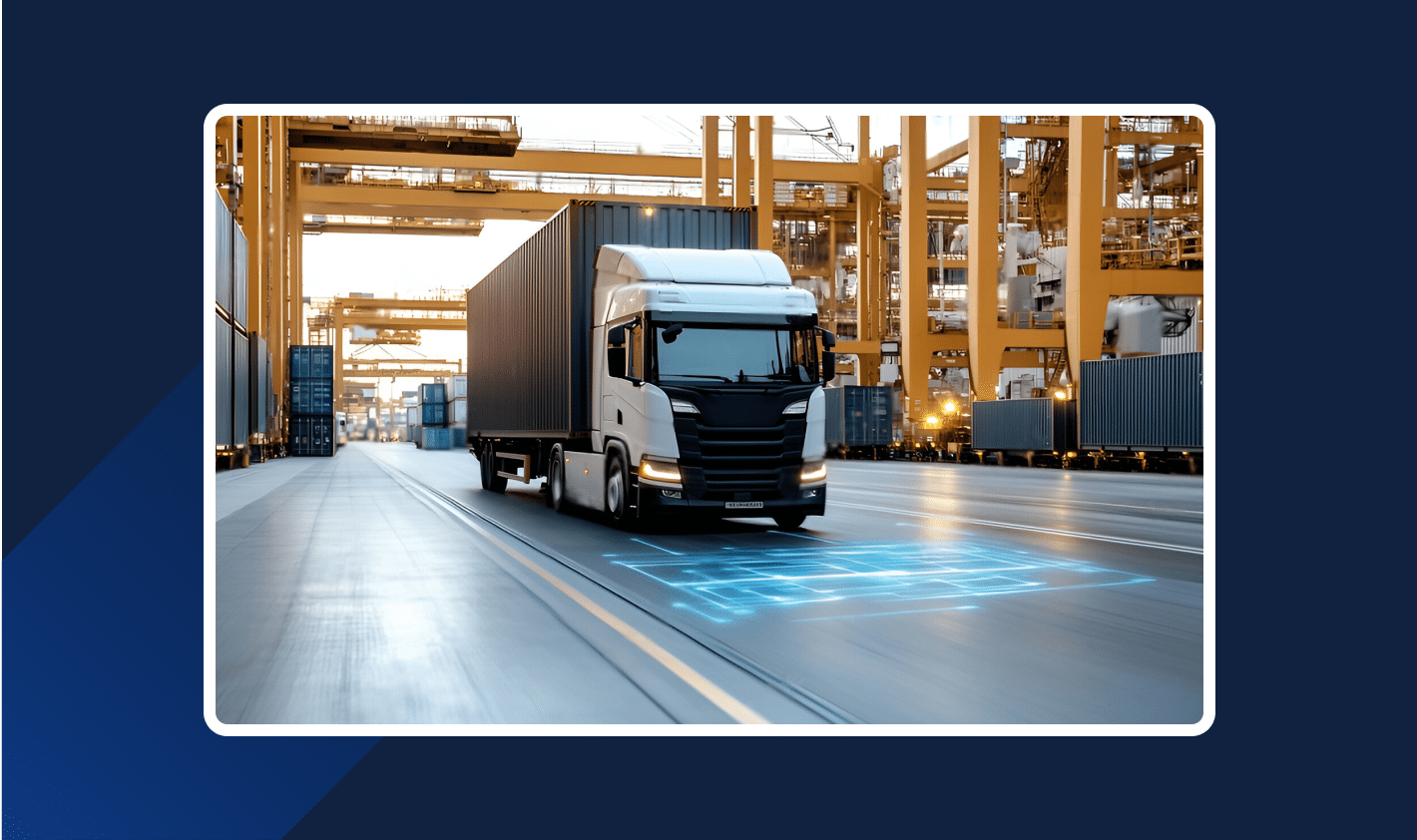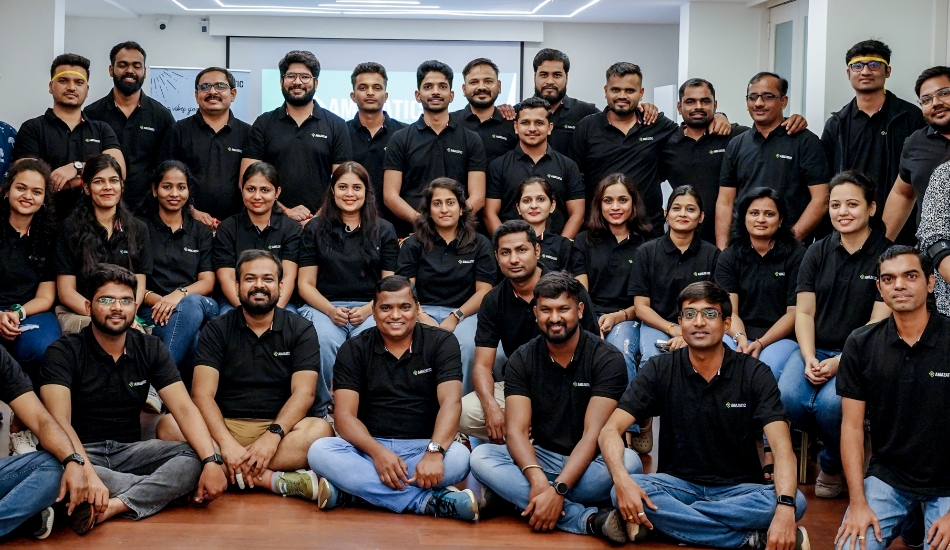
The US trucking industry moves about 73% of all freight by volume and nearly 77% of freight revenue in the country (American Trucking Associations, 2025). It is the circulatory system of commerce. But it operates under relentless pressure: fuel costs that account for nearly a quarter of expenses, driver shortages, sustainability demands, and razor-thin margins.
AI in the US trucking industry is helping fleets optimize routes, reduce downtime, match freight more efficiently, improve driver safety, and gain clearer operational visibility.
And it’s delivering measurable results — not hype.
Smarter Routing: AI Route Optimization in Trucking
Fuel is the single largest variable cost for most US fleets. Trucks typically consume 12,000–20,500 gallons of diesel per year, with fuel costs accounting for ~24% of total operating expenses (Fleetio, 2024). Any meaningful savings here go straight to profitability.
AI-driven route optimization is already moving the needle. Unlike static GPS-based routing or traditional transportation management systems, AI platforms consume a broad range of real-time and historical data:
- Traffic patterns
- Road closures and restrictions
- Weather impacts
- Fuel prices and refueling stops
- Customer delivery windows
- Load weight and balance considerations
These models run continuously, allowing dynamic re-optimization mid-route — not just static pre-trip plans.
The outcomes are clear:
- Fuel savings: AI-based routing typically delivers 15%–25% reductions in fuel use; some fleets report up to 28% savings (Intangles; industry case studies; fleet performance studies). On a $60,000 annual fuel spend, that’s $9,000–$15,000 per truck per year.
- On-time deliveries: Improved by 20%, as AI enables real-time adjustments to delays from weather, accidents, and congestion (US Department of Energy).
- Overall logistics costs: Down by 15%, with 65% better service levels (McKinsey, 2025).
Large US carriers are seeing this firsthand. Werner Enterprises’ AI-powered dynamic routing and driver tech suite helped optimize fleet efficiency and customer service, earning a 2024 Top Supply Chain Projects Award (Werner Enterprises).
For mid-market and SME fleets — where margins are thinner and optimization has outsized impact — this capability is no longer optional.
Preventing Downtime: The Power of AI Predictive Maintenance in Trucking
Truck downtime isn’t just a nuisance; it’s an earnings killer. Each day a truck sits idle costs $448–$760 in lost revenue (Fleet Management Weekly, 2024). Add towing, repairs, customer penalties, and lost future business — and the real impact is larger.
Traditional preventive maintenance (fixed schedules) often results in two extremes: parts being replaced too early (driving up costs), or too late (causing breakdowns). Predictive maintenance powered by AI solves this.
By continuously analyzing real-time data from truck sensors (engine temperatures, brake wear, vibration patterns, oil condition, emissions anomalies), AI models can accurately predict when components are nearing failure — and schedule maintenance proactively.
- Downtime reductions: 30%–50% fewer unplanned failures (McKinsey).
- Maintenance cost reductions: 10%–40% lower spend on emergency repairs and parts (McKinsey).
- Asset lifespan: Extended by 20%–40% (McKinsey).
Major operators such as Volvo, Daimler Trucks, and FedEx already leverage AI-based predictive maintenance (leading fleet operators and OEMs; Deloitte). Cummins reported annual savings of $268,000 through AI-optimized post-assembly maintenance processes.
For SME fleets, predictive maintenance is particularly valuable — they often can’t afford spare trucks sitting idle or the costs of unscheduled downtime disrupting already lean operations.
Freight Matching with AI: Cutting Empty Miles and Boosting Profitability
Empty miles are an invisible cost driver in trucking. Industry-wide, 20%–35% of all miles driven by US trucks are empty (Uber Freight; Covenant Logistics; Trinity Logistics). The cost is staggering: wasted fuel, driver hours, maintenance, and — importantly in today’s ESG-focused world — unnecessary emissions.
AI-powered freight matching platforms address this head-on. They continuously analyze available loads, truck capacity, driver hours, routing constraints, and historical demand to match freight to trucks with far greater efficiency than traditional manual brokering.
The impact:
- Uber Freight: Reduced empty miles from 25% to 22%, saving 4 million empty miles in one year. They estimate potential industry-wide reductions of up to 64% (Uber Freight).
- Convoy: Independent case studies show 25% reduction in transportation costs through smarter backhaul optimization.
- Loadsmart: Reports 20%+ empty mile reductions in specific fleet applications.
Reducing empty miles not only cuts fuel and maintenance costs, but also helps meet corporate sustainability targets — increasingly required by shippers and investors alike.
For SMEs operating in regional lanes or brokerage-heavy freight markets, AI-based freight matching can be a high-ROI starting point for AI adoption.
AI Driver Monitoring in Trucking: Making Roads Safer
13% of US truck crashes are linked to driver fatigue, and 16%–18% to distraction (FMCSA; NHTSA). Beyond the human cost, accidents drive massive financial losses — higher insurance premiums, vehicle damage, legal exposure, and reputational harm.
AI-powered driver monitoring and coaching helps reduce this risk dramatically. Advanced systems use cabin-facing cameras and real-time AI to detect:
- Fatigue
- Distraction (cell phone use, eating, eyes off road)
- Aggressive driving (hard braking, cornering, speeding)
The results are measurable:
- Fleets using Netradyne, Samsara, and AI-based driver coaching platforms have seen 22%–30% reductions in accidents.
- Load One reduced claims by 59% after deploying Netradyne.
- Driver distraction events dropped by 60% within weeks in some fleets.
- Fleets report 5%–20% reductions in insurance premiums after adopting AI-based monitoring (FreightWaves).
For SME fleets — often penalized with higher insurance rates due to smaller size and perceived risk — AI-based driver safety programs can deliver outsized financial gains and improve driver retention through personalized coaching.
Fleet-Wide Intelligence: How AI Is Driving Smarter Trucking Operations
In many trucking companies, data is fragmented — siloed across maintenance software, TMS, telematics systems, fuel cards, and compliance platforms. That limits operational visibility and slows decision-making.
AI-based fleet intelligence platforms change this. They aggregate data from across the operation — and apply AI to surface insights that improve both daily performance and strategic planning.
Adoption is growing fast: 51% of US fleets now use AI-based platforms for operational intelligence (Fleet Owner; Webfleet Study, 2024).
Key impacts reported:
- Maintenance cost reductions: 20%–30% (Q3 Tech).
- Fuel savings: Up to 15% through optimized routing and driving behavior.
- Fleet utilization: Higher uptime and improved asset allocation — critical in markets with tight driver capacity.
- Customer satisfaction: Improved on-time deliveries and transparency.
Gartner projects the fleet management market will reach $16B globally by 2025, driven by the demand for such capabilities.
For SME operators, AI-based fleet intelligence offers a path to compete with larger carriers — making data-driven decisions without needing a large internal IT staff.
What’s Next for AI in US Trucking Industry?
Autonomous Trucks: Still Early Days
Fully autonomous (Level 4) trucking remains in pilot mode—less than 1% of fleets are actively testing Level 4 autonomy (ResearchAndMarkets). But McKinsey projects 13% of heavy-duty US trucks could be autonomous by 2035.
Emissions Reduction and ESG Targets
AI-powered routing and freight optimization can cut emissions by up to 10% (World Economic Forum). For fleets facing ESG reporting requirements or shipper demands, this is fast becoming a must-have capability.
Back-Office Automation with AI
AI can now automate 60%–80% of back-office tasks — billing, compliance, documentation — freeing up staff time and reducing errors (AI workflow automation reports; ARDEM). For SMEs, this directly lowers overhead costs.
Final Thought: The Road Ahead for AI-Powered Trucking Solutions
The US trucking industry is massive — $900B+ in revenue, 11B tons of freight moved annually (American Trucking Associations). But it faces growing headwinds: operational costs at record highs, driver shortages, sustainability pressures, and volatile markets.
AI won’t eliminate these challenges — but it will increasingly define which fleets win despite them.
Fuel optimization, predictive maintenance, freight matching, driver safety, unified intelligence — these are no longer “innovation projects.” They’re becoming core operational capabilities.
How Amazatic Helps US Trucking and Transportation SMEs
AI adoption often feels out of reach for SME fleets. Limited IT budgets. Time-strapped leadership. Complex vendor ecosystems.
That’s where Amazatic helps.
We partner with US trucking and transportation SMEs to:
- Implement AI-powered route optimization with immediate fuel and service gains.
- Deploy predictive maintenance to prevent costly downtime.
- Enable AI-based freight matching to cut empty miles.
- Roll out driver monitoring and coaching to lower risk and insurance costs.
- Build practical fleet intelligence dashboards that drive smarter decisions — without requiring a team of data scientists.
And we do it fast, pragmatically, and with a focus on business outcomes — not tech jargon.
Want to see how your fleet can start benefiting? Contact us www.amazatic.com and let’s talk about your priorities.

